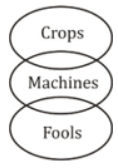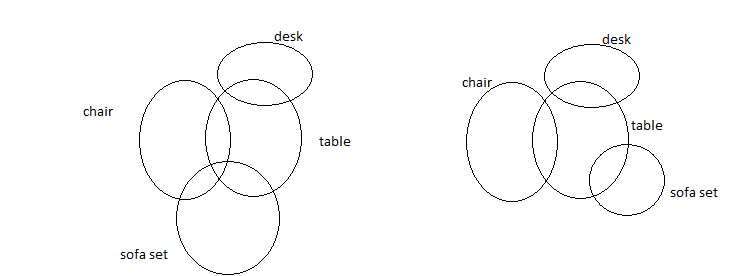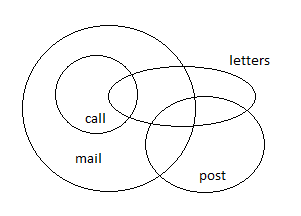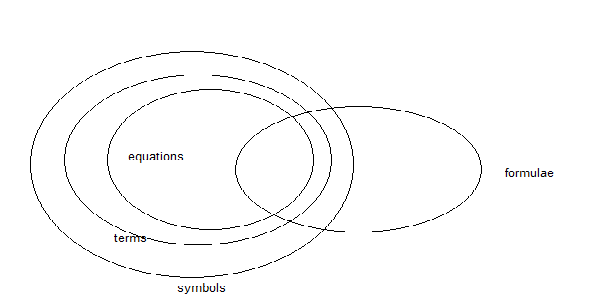Syllogism Questions for IIFT PDF
Download important IIFT Syllogism Questions PDF based on previously asked questions in IIFT and other MBA exams. Practice Syllogism questions and answers for IIFT exam.
Download Syllogism Questions for IIFT PDF
Get 50% Off on IIFT & Other MBA Test Series
Download IIFT Previous Papers PDF
Question 1: In the following question, two statements are given each followed by two conclusions I and II. You have to consider the statements to be true even if they seem to be at variance from commonly known facts. You have to decide which of the given conclusions, if any, follows from the given statements.
Statements:
(I) Most crops are machines.
(II) Some machines are fools.
Conclusion:
(I) Some fools are machines.
(II) Some crops are fools.
a) Conclusion I follows
b) Conclusion II follows
c) Neither I nor II follows
d) Both I and II follows
Instructions
In each of following questions have the respective statements and related conclusions .you have to take given statement is as correct and answer the following questions
Question 2: statements
Some windows are doors
All doors are walls
No wall is a roof
All roofs are shelters
Conclusions:
Some windows are walls
No wall is shelter
No door is shelter
a) None follows
b) only II and III follows
c) only I and III follows
d) only I follows
e) None of these
Instructions
In each question below are three statements followed by two conclusions numbered I and II. You have to take the three given statements to be true even if they seem to be at variance from commonly known facts and then decide which of the given conclusions logically follows from the three statements disregarding commonly known facts. Then decide which of the answers a, b, c, d and e. is the correct answer.
Give answer a: if only conclusion I follows.
Give answer b: if only con elusion II follows.
Give answer c: if either I or II follows.
Give answer d: if neither I nor II follows.
Give answer e: if both I and II follow.
Question 3: Statements :
Some chairs are tables.
Some tables are desks.
No desk is sofaset.
Conclusions:
I. Some chairs are sofasets.
II. No chair is sofaset.
a) if only conclusion I follows.
b) if only con elusion II follows.
c) if either I or II follows.
d) if neither I nor II follows.
e) if both I and II follow.
Instructions
In each of the questions below are given three statements followed by two conclusions numbered I and II. You have to take the given statements to be true even if they seem to be at variance from commonly known facts. Read all the conclusions and then decide which of the given conclusions logically follows from the given statements disregarding commonly known facts.
Give answer a: if only Conclusion I follows.
Give answer b: if only Conclusion II follows.
Give answer c: if either Conclusion I or II follows.
Give answer d: if neither Conclusion I nor II follows.
Give answer e: if both Conclusions I and II follow.
Question 4: Statements :
All windows are doors.
Some doors are buildings.
All buildings are cages.
Conclusions :
I. Some cages are doors.
II. Some buildings are windows.
a) if only Conclusion I follows.
b) if only Conclusion II follows.
c) if either Conclusion I or II follows.
d) if neither Conclusion I nor II follows.
e) if both Conclusions I and II follow.
Instructions
In each question below are two/three statements followed by two conclusions numbered I and II. You have to take the two/three given statements to be true even if they seem to be at variance from commonly known facts and then decide which of the given conclusions logically follows from the given statements disregarding commonly known facts.
Give answer
a: if only conclusion I follows.
b: if only conclusion II follows.
c: if either conclusion I or conclusion II follows .
d: if neither conclusion I nor conclusion II follows.
e: if both conclusion I and conclusion II follow.
Question 5: Statements :
All kites are birds.
All aeroplanes are kites.
No bird is a fish.
Conclusions :
I. No fish is a kite:
II. All aeroplanes are birds.
a) if only conclusion I follows.
b) if only conclusion II follows.
c) if either conclusion I or conclusion II follows .
d) if neither conclusion I nor conclusion II follows.
e) if both conclusion I and conclusion II follow.
Practice IIFT Mock Tests
Question 6: Statements
All calls are mails.
Some mails are posts.
Some posts are letters.
Conclusions
I. All mails are calls.
II. No call is a letter.
a) if both the Conclusion I and Conclusion II follow
b) if either Conclusion I or Conclusion II follows
c) if neither Conclusion I nor Conclusion 11 follows
d) if only Conclusion I follows
e) if only Conclusion II follows
Instructions
In each of the questions given below two/three statements followed by two Conclusions numbered I and II have been given. You have to take the two/ three given statements to be true even if they seem to be at variance from commonly known facts and then decide which of the given Conelusions logically follows from the given statements disregarding commonly known facts.
a: if only Conclusion II follows
b: if only Conclusion I follows
c: if both the Conclusion I and Conclusion II follow
d: if either Conclusion I or Conclusion II follows
e: if neither Conclusion I nor Conclusion II follows
Question 7: Statements :
Some equations are formulae.
All equations are terms.
All terms are symbols.
Conclusions :
1. All equations are symbols.
II. No symbol is a formula.
a) if only Conclusion II follows
b) if only Conclusion I follows
c) if both the Conclusion I and Conclusion II follow
d) if either Conclusion I or Conclusion II follows
e) if neither Conclusion I nor Conclusion II follows
Question 8: Statements:
Some strikes are hits.
No strike is a raid.
All attacks are raids.Conclusions :
I. Some hits are definitely not raids.
II. All hits being strikes is a possibility.
a) if only Conclusion II follows
b) if only Conclusion I follows
c) if both the Conclusion I and Conclusion II follow
d) if either Conclusion I or Conclusion II follows
e) if neither Conclusion I nor Conclusion II follows
Instructions
In the following two questions, one statement is given followed by two Conclusions, I and II. You have to consider the statement to be true, even if it seems to be at variance from commonly known facts. You are to decide which of the given conclusions can definitely be drawn from the given statement. Indicate your answer.
Question 9: Statement : Aggressive animals can be trained with care and affection to behave
as the occasion demands.
Conclusions
I. Trained dogs cannot be aggressive.
II. Animals are always aggressive unless care and affection is given to them.
a) Both I and II follow.
b) Only I follows.
c) Only II follows.
d) Neither I nor II follows.
Instructions
In each of the question below are given four statements followed by three conclusions numbered I, II and III. You have to take the given statements to be true even if they seem to be at variance from commonly known facts. Read all the conclusions and then decide which of the given conclusions logically follows from three given statements disregarding commonly known facts.
Question 10: Statements:Some beads are chairs.
All chairs are trucks.
Some trucks are bricks.
All bricks are cars.
Conclusions:I.Some cars are chairs.
II.Some cars are trucks.
III.Some trucks are beads.
a) Only I and II follow
b) Only I and III follow
c) Only II and III follow
d) All I, II and III follow
e) None of these
Answers & Solutions:
1) Answer (A)
The venn diagram for above statements is :

Conclusion:
(I) Some fools are machines = true
(II) Some crops are fools = false
Thus, only conclusion I follows
=> Ans – (A)
2) Answer (D)
The venn diagram for above statements is :

Conclusions:
Some windows are walls = true
No wall is shelter = may be true
No door is shelter = may be true
Thus, only I follows.
=> Ans – (D)
3) Answer (C)
following 2 venn can be drawn from the above given statements

from the above two venn we can say that either of the two conclusion can be true
4) Answer (A)
The venn diagram for above statements is :

Conclusions :
I. Some cages are doors = true
II. Some buildings are windows = may or may not be true
Thus, only Conclusion I follows.
=> Ans – (A)
5) Answer (B)
.Download IIFT Previous Papers PDF
6) Answer (C)
from the above statements following venn can be drawn

we can see from the above venn that no conclusion is true
7) Answer (B)
following venn diagram can be drawn from the given data

and hence we can say that only conclusion 1 is true.
8) Answer (C)
As some hits are strikes and no strike is a raid, some hits are definitely not raids. Hence, conclusion I follows.
As the extent of overlap between hits and strikes is not known, conclusion II follows. Hence, both conclusions follow.
9) Answer (D)
The statement indicates that aggressive animals can be trained to behave but it does not conclude that all animals are in their aggressive mindset before training, or trained dogs may or may not be aggressive.
Thus, neither conclusion follows.
=> Ans – (D)
10) Answer (C)
The Venn Diagram for the given syllogism is as shown below:

Based on the diagram, atleast some cars are trucks and atleast some trucks are beads. Hence conclusions II and III follow. However, from the diagram, we can clearly see that none of the cars are chairs. So, conclusion I is not implied in every case.
IIFT Previous year question answer PDF
We hope this Syllogism questions and answers for IIFT PDF will be helpful to you.





![CAT Averages Questions PDF [Important Questions] CAT AVERAGES Questions PDF](https://cracku.in/blog/wp-content/uploads/2022/07/CAT-AVERAGES-Questions-PDF-218x150.png)